The very thought of a clogged bathroom sink is enough to induce a shiver of disgust.
You know the ordeal of unclogging it is going to be wet, slimy, and stinky.
When it comes to clogged drains, clogged toilets and kitchen sinks are pretty easy to figure out.
However, clogged sink drains are quite often a mystery, since the only things that go down them are soap and water.
So how could they possibly become blocked?
Well, there are several reasons why.
Why Does Your Bathroom Drain Keep Getting Clogged?
Although it may seem that only soapy water makes it way down your bathroom drain, there are a whole many other things that can clog your sink.
Hair
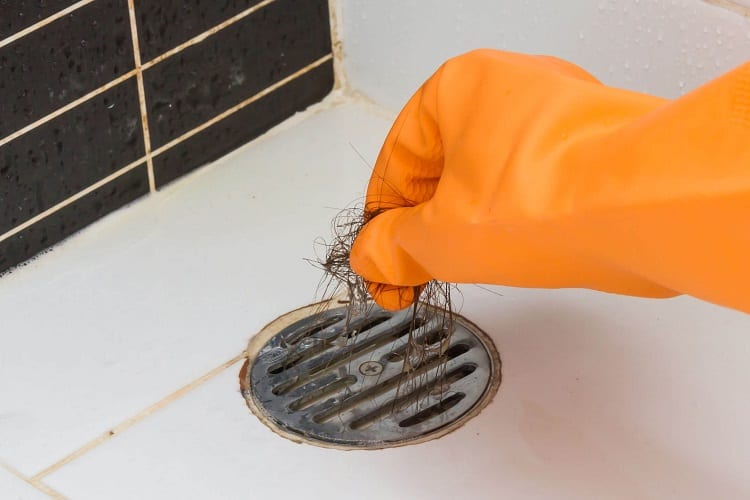
A prevailing myth about hair is that only certain type of hair clogs drains. That isn’t true.
Facial hair and pet hair also has the tendency to block your drain pipes. Regardless of whether your hair is fine or coarse, it can grab onto pipes.
When hair gets wet, it clumps together making it the perfect material to clog pipes.
This hair collects more hair and soap scum that helps to bind it together even strongly.
Over time, the clump gets large enough to block the entire flow of water in the pipe.
Small Objects
Tiny objects like earring stoppers, dental floss, chunks of hard soap, and even grease from your hands can all form clogs in the P-trap of your pipe.
If this clogs, you may hear strange rattling or stuttering noises as water goes down the drain.
To get rid of this block, you can easily remove the P-trap from below your sink. You can then clean it out using an old toothbrush.
Warning: The P-trap may have dirty water trapped in it, so be careful you don’t get splashed with it when you take out the pipe.
Soap Scum
Soap scum can build over time inside the drain of your sink.
Soap scum occurs when the soap chemicals react with magnesium and calcium in water and form a chalky, sticky film on the walls of the pipe.
This film builds up over time and catches other falling material, blocking your pipe.
Soap scum can cause a particularly stubborn clog since it is not easy to remove.
Particularly strong soap can even damage the pipes by corroding them over time.
Pipe Damage
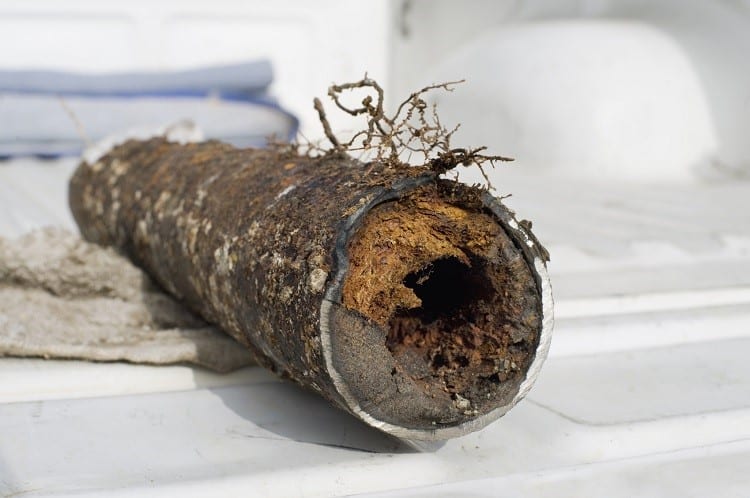
Damaged pipes can also cause restriction of water flow. All types of damage can cause blockages.
When rust builds up on the inside of pipes, it can cause clogs. If your pipes are dented heavily, they may constrict water flow.
Worn out pipes joints can break apart, making the pipes sag and restrict water flow. Improperly fastened pipes may shift and become disconnected.
Pipe damage is almost inevitable. Over time, pipes will grow old and will start to break apart.
If that happens, the only thing you can do is to replace them with new pipes.
If your pipes are not old but keep getting clogged, something else may be causing a clog.
How Does a Bathroom Drain Work?
Bathroom drains work with the help of gravity and pressure. As water falls down the sink’s appliance line, it picks up speed.
This speed allows it to pass the p-trap and the drainpipes in your home.
A p-trap is the “P” shaped curve of pipe attached directly beneath your sink drain and connects it to the drain line that leads to the sewers.
The function of a P-trap is to prevent waste water, odorous gases, and sewage backflow from making its ways into your home.
The p-trap does this by holding water, which creates suction and allows water to drain. However, the p-trap often catches other objects too.
As the water flows down the p-trap and goes down the sink line, it joins up with a series of longer drain pipes.
Drainpipes come in many sizes to better accommodate the type of waste flowing through it.
Since bathroom sinks only transport water and soap, the drain pipes there aren’t very wide and are liable to clog.
Your home’s drain pipes are also connected to your plumbing air vent.
This is a long and narrow tube that runs vertically and supplies fresh air into the drain pipes so that vacuum is not created in the pipes and block water flow.
As long as your drain pipes are clear and your vent is open, water can easily move from your sink to the sewers.
What Can Dissolve Hair in a Drain?
As you may already know, hair in your drain can cause serious clogs, which are further exacerbated by grease and oils.
Additionally, if you have hard water coming into your home, the minerals from this react with soap to from soap scum that is super sticky and encourages more hair to stick to the drains.
What’s worse is that hair often travels to the larger drain lines or the main sewerage line, and makes blockages there.
When this happens, you have no choice but to call a plumber.
If your bathroom sinks started polling water, chances are you are dealing with a hair clog.
However, despair not. There are plenty of DIY home remedies that you can use to dissolve the hair in your drainpipes.
Baking Soda and Vinegar Solution
A fizzy solution of baking soda and vinegar is powerful enough to unclog hair in your pipes.
- Boil a tea kettle of water and then pour the boiling water down the drain. Wait for a couple of minutes.
- Make a solution of one-fourth cup of baking soda and a cup of vinegar.
- While the mixture is still fizzing, quickly run it down the drain.
After a while, you may hear a gurgling, burping sound coming from your drain.
This may be accompanied by some bad odors so you should leave the bathroom during this time.
Wait 20 minutes as the solution does its work and then pour another kettle of boiling hot water down the drain.
If you run some water now, there is a good chance it will not pool up and easily go down the drain.
Alternatively, you can also use these methods:
Baking Soda and Salt
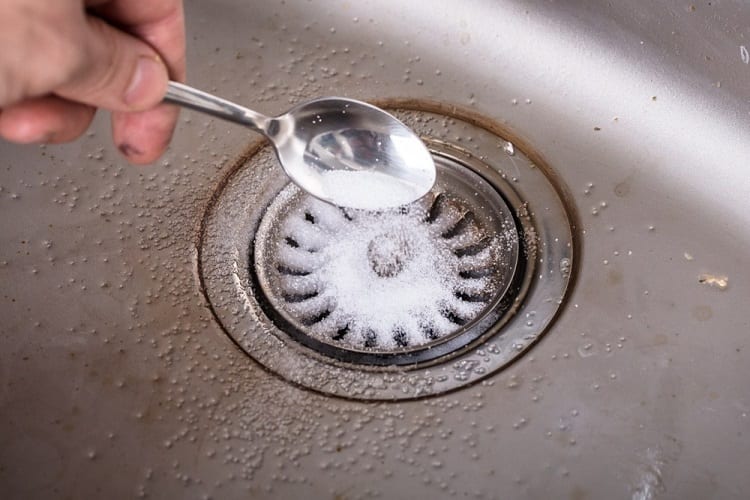
If you don’t feel the previous method if effective, you can try one with salt instead.
This is a great alternative for hair clogs in your bathroom drains.
- Make a mixture of one cup baking soda and half a cup of salt.
- Pour the mixture down the drain and let it rest overnight.
- You may hear fizzing and popping sounds in the drain, which is a good sign.
- In the morning, boil a few cups of water and flush it down the drain.
Hopefully, the baking soda will have dissolved the balls of hair in your drain and left your drain pipes clear.
Chemicals
If you have tried both the methods above but still do not have clear pipes, then you can resort to the use of chemicals.
Although, it is not advisable to use chemicals all the time for hair clogs, sometimes, they are the only options left.
However, make sure you wear safety clothing like gloves and goggles while using chemicals since they can be very caustic and emit toxic fumes.
There are a lot of commercially available strong chemical drain openers that you can find in any supermarket.
- Make sure you follow the instruction on the packaging and avoid using the amount over that.
- Do not mix various chemicals together in a bid for an extra-effective solution. This can create noxious toxic gasses.
- Pour the chemical down the drain.
You may hear belching sounds coming from your drain as hair is dissolved and the drainpipes are unclogged.
Using chemicals to unclog the hair in your drainpipes is a common and time-tested method.
However, make sure you do not use harsh chemicals lightly as it has the potential to rot your pipes from the inside out over the long run.
Will Bleach Unclog a Drain?
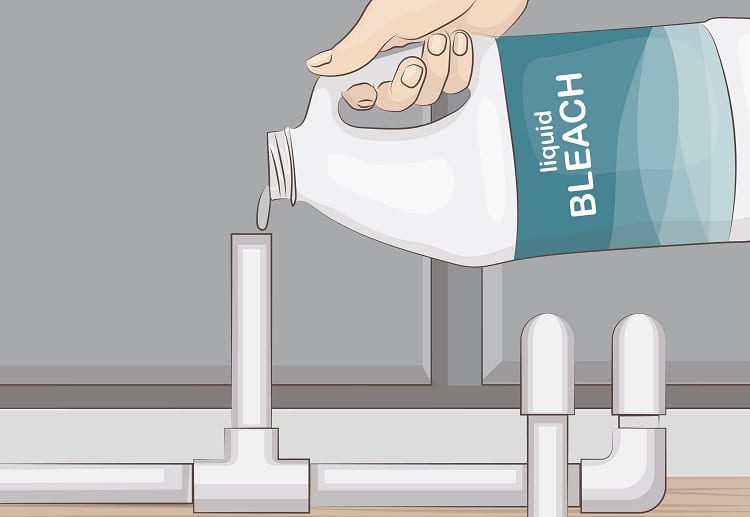
Bleach is a caustic agent. You may have been warned about getting bleach on your skin as it is very corrosive and can burn you.
This is the same reason why it can be used to dissolve hair. Hair has acidic properties while chlorine bleach is strongly basic.
As such, when it comes into contact with hair, it neutralizes the bonds between hair and breaks it down.
- Take a cup of undiluted chlorine bleach and run it down the drain.
- Wait for half an hour as the bleach destroys the hair in the pipes.
- Run some water to see if it is flowing down.
- If the pipe is only partially blocked, pour another cup of bleach.
This will be effective in clearing the hair from your drain.
However, a lot of people are concerned over whether bleach can damage their pipes.
Can Bleach Damage PVC Pipes?
No, bleach does not damage PVC pipes.
Polyvinyl chloride pipes are made by undergoing thermosetting, which turns the pipes resistant to many corrosive chemicals, like chlorine bleaches and drain openers.
Therefore, there is no harm in using bleach to open up these drains — provided you follow the right instructions.
If you use bleach in moderate quantities and with caution, there is no worry that you may damage your drain pipes.
Here are a few things you need to take care of:
- Do not use more than the recommended amount of bleach. If you unload a full bottle of bleach down the drain, then yes, your pipes may be damaged.
- Additionally, bleach can react with other chemicals and substances, like ammonia, in your drain. If you use a huge amount, it can create a lot of toxic fumes.
- Never mix bleach with other commercial drain openers as it can cause dangerous chemical reactions.
- Although PVC pipes are designed to tolerate pure sodium hypochlorite, it is not a bad idea to dilute it.
- Using too much bleach can also kill the bacteria in your sewage system that are responsible for breaking down your waste and can result in other malfunctions.
Having said that, there are other options available that are safer and more effective than bleach to clear out hair. You should first try those out.
If all you need is to clean the outsides of your pipes, then bleach is a good option.
Dilute one-fourth cup of bleach in a cup of water and rub your pipes with the solution to make them clean and shiny.
Remember to always wear protective gloves when handling bleach.
Can Coke Unclog a Drain?
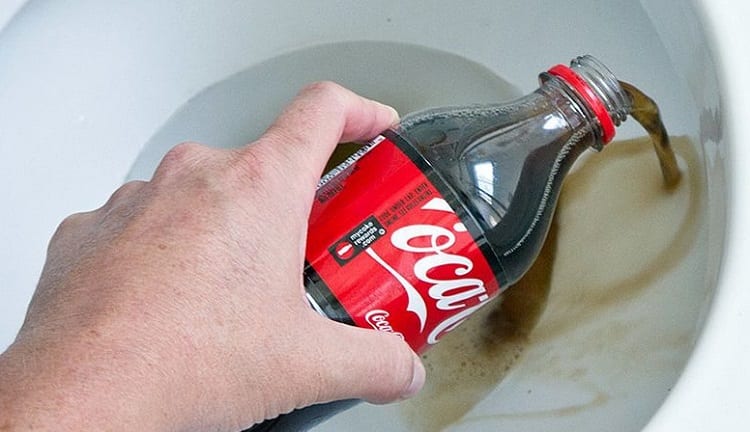
Most of you will be surprised to hear that a bottle of Coca-Cola can do wonders when it comes to unclogging drains.
Many of you may have heard how effective glass of coke is in dissolving a nail over time.
Although we have never experimented with this, dark-colored soda drinks are certainly effective in removing clogs from your drains.
Coca-cola contains phosphoric acid, which is responsible for the unique tang that people love.
It also prevents the growth of mold and bacteria in the drink.
Even though it may sound dangerous, phosphoric acid is not toxic.
However, it is certainly quite an effective drain cleaner due to its corrosive dissolving properties.
Phosphoric acid can even get rid of the lime scales and other mineral build ups inside the pipes that commercially available drain openers struggle to clean.
Phosphoric acid is found in most dark-colored sodas, so make sure you check the list of ingredients.
Here is how you can use coke to clean out your drain:
- Get a two-liter bottle of Coca-Cola and let it sit on the countertop until it achieves room temperature.
- Pour the bottle down the clogged drain
- Let the liquid sit in your drain for a couple of hours.
- Boil a tea kettle of water and pour it down the drain
- If the drain is only partially clogged, repeat the process.
If the water still does not run down the drain, it may have an obstacle that the phosphoric acid alone cannot dissolve.
You may need some plumbing equipment to get the mysterious obstruction out.
Using a Plunger
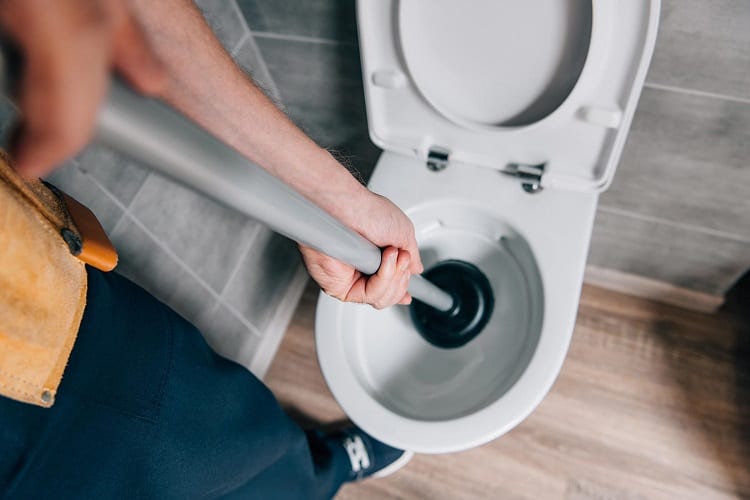
Although this may seem very old-school, using a plunger to dislodge the debris in your drain is one of the most effective ways to unclog your drain.
The design of your drain pipes, where the clog is situated, and what is causing the blockage, all are contributing factors in how much you have to struggle to unclog the pipe.
Here’s how you can unclog your drain pipe:
- Add a dollop of petroleum jelly to the edges of the suction pad so that they can grip the drain more firmly.
- Run some water so that the end of the suction pad is immersed in it.
- Plunge vigorously to suck out whatever is stuck in your pipes.
You may not meet with much success if the blockage is located some way down your drain pipe.
In that case, using a hook or a plumber’s snake are two other great options.
Using a Hook
This is one of the oldest methods to unclog a bathroom drain and has quite a high success rate.
You can fashion a hook out of an old wire hanger quickly. This should be done if you can’t reach the blockage with your hands.
- Probe your hanger deep into the drain, with the hook at the front.
- You may find a bit of resistance that may be the blockage.
- Pull out your hanger and the hook will drag whatever is blocking your drainpipe out.
Fair warning: This can get very gross.
If your drainpipe is clogged with soap scum or mineral buildup, this is not the best method to get rid of it.
Using a Plumber’s Snake
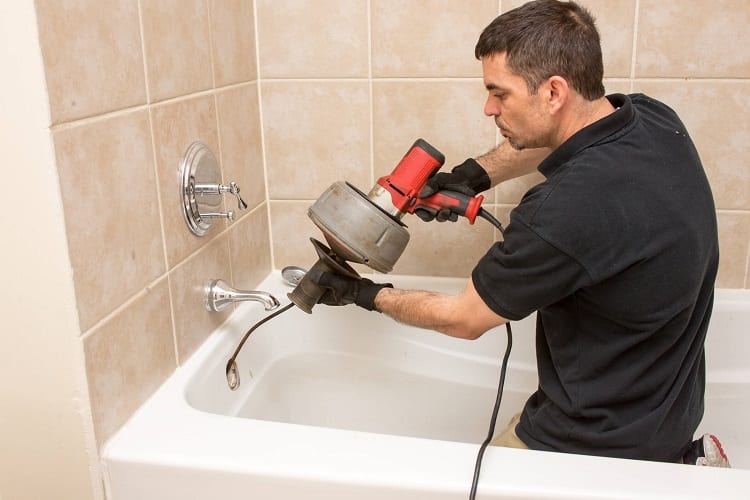
This is another effective and affordable method to unclog your drain pipes and has quite a good success rate.
A plumber’s snake is a long and flexible auger or coiled wire that is used to pull out drain pipe augers that cannot be loosened by a plunger.
To use this:
- Push the long snake down the drain until you meet with resistance. This is the clog.
- Pull out the wire by turning the plumber’s snake handle and coiling back the wire.
- If you are lucky, you will see a lot of gunk clinging to the wire of the snake.
- Repeat the process until your drain pipe is completely clog-less.
- Run water to verify the obstruction is completely removed.
Some clogs may be caused by encroaching tree roots and these cannot be removed by a plumber’s snake.
To unclog those, you will need to call in a plumber.
Bottom Line
When it comes to your drain system, prevention is always better.
If you want to minimize the chances of your bathroom drain being clogged, you should buy a drain protector to catch hair and other objects from falling down the drain.
A secure soap dish can also prevent soap from dripping down into your drain and forming soap scum that causes more clogs.
If you have tried all these methods and still haven’t been effective in clearing out your drain, call a professional plumber.
